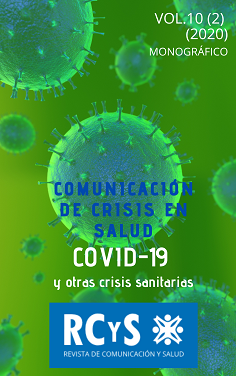The COVID-19 on the front pages of national newspapers in Spain
DOI:
https://doi.org/10.35669/rcys.2020.10(2).265-286Keywords:
Pandemic, COVID-19, coronavirus, Spain, newspapers, front page, headlinesAbstract
This research analyses the treatment of the COVID-19 pandemic on the front pages of the newspapers ABC, El País, El Mundo, La Razón and La Vanguardia during the months of February, March and April 2020. The analysis allows us to compare similarities and differences while observing the evolution in this period. Content analysis is used to determine the space and importance of the topic within the covers, as well as the issues being addressed, who the protagonists are in the headlines or photographs and the lexicon they use. The analysis focuses on how events are communicated while uncovering differences in approach and style between national headlines. The results and conclusions show that the information about COVID-19 gains prominence and takes up more space on the front pages as the weeks go by, and graphics and infographics are included as the incidence of COVID-19 increases. It can also be seen from the analysis of the covers that the issues addressed by the newspapers vary over time, as does the vocabulary used, which is characteristic of each medium.
Downloads
References
AIMC (2020). Ranking de diarios. 1ª Ola. Disponible en: http://reporting.aimc.es/index.html#/main/diarios
Andreu-Sánchez, C., & Martín-Pascual, M. Á. (2020). Fake images of the SARS-CoV-2 coronavirus in the communication of information at the beginning of the first Covid-19 pandemic. El Profesional de la Información, 29(3), e290309. doi: 10.3145/epi.2020.may.09
Berrocal Gonzalo, S. y Rodríguez-Maribona, C. (1998). Análisis básico de la prensa diaria. Manual para aprender a leer periódicos. Madrid: Universitas
Borrat, H. (2003): “Narradores en interacción”. I/C. Revista científica de información y comunicación, 1, pp. 59-84.
Cinelli, M., Quattrociocchi, W., Galeazzi, A., Valensise, C. M., Brugnoli, E., Schmidt, A. L., ... & Scala, A. (2020). The covid-19 social media infodemic. arXiv preprint arXiv:2003.05004. doi: 10.1038/s41598-020-73510-5
Departamento de Seguridad Nacional (2020). Disponible en http://dsn.gob.es
Dircomfidencial (2020, 28 enero). Los grandes periódicos impresos cierran otro año negro en difusión de ejemplares. Disponible en: https://dircomfidencial.com/medios/continuan-un-ano-mas-las-caidas-de-la-difusion-en-papel-de-los-principales-diarios-generalistas-espanoles-20200128-0401/
Francescutti, L. P. (2003). «Vacas locas» y comunicación del riesgo: un análisis de la prensa española. Política y sociedad, 40(3), 153-188. Recuperado de https://revistas.ucm.es/index.php/POSO/article/view/POSO0303330153A/23530
Fusté-Forné, F. (2020). Explicar el virus desde las portadas: un estudio de los periódicos españoles. Revista Española de Comunicación en Salud, 210-217. doi: 10.20318/recs.2020.5409
González, R. B., & Cambra, U. C. (2015). El virus del ébola: análisis de su comunicación de crisis en España. Opción, 31(4), 67-86. Recuperado de https://www.produccioncientificaluz.org/index.php/opcion/article/view/20539
Grijelmo, A. (2020). “El periodismo en tiempos de coronavirus”, en El País. Disponible en https://elpais.com/elpais/2020/04/24/el_pais_que_hacemos/1587714100_071847.html
Informe Quiral (2008). Medicina, Comunicación y Sociedad. Fundació Vila Casas (Universitat Pompeu Fabra). Disponible en https://www.fundaciovilacasas.com/es/informe-quiral/pagina-2
López-Rabadán, P. y Casero-Ripollés, A. (2012). La evolución de la agenda mediática española (1980-2010). Un análisis longitudinal de la portada de la prensa de referencia. Revista Latina de Comunicación Social, 67, 470-493. Disponible en: http://www.revistalatinacs.org/067/art/964_Castellon/20_Casero.html
Maciá-Barber, C. (2020). COVID-19 en portada: radiografía ética de la cobertura fotográfica de la pandemia en España. Revista Española de Comunicación en Salud, 42-58.
McCombs, M. (2006). Estableciendo la agenda. Barcelona: Paidós Comunicación
Martínez Solana, Y. (2004). La crisis de las “vacas locas” en España: la necesidad de una información sanitaria responsable. Estudios Sobre El Mensaje Periodístico, 10, 139- 158. Recuperado de https://revistas.ucm.es/index.php/ESMP/article/view/ESMP0404110139A
Masip, Pere; Aran-Ramspott, Sue; Ruiz-Caballero, Carlos; Suau, Jaume; Almenar, Ester; Puertas-Graell, David (2020). “Consumo informativo y cobertura mediática durante el confinamiento por el Covid-19: sobreinformación, sesgo ideológico y sensacionalismo”. El profesional de la información, 29(3), e290312. doi: 10.3145/epi.2020.may.1
Monjas-Eleta, M. y Gil-Torres,A. (2019). Comunicación institucional y tratamiento periodístico de la crisis del ébola en España entre el 6 y el 8 de octubre de 2014. Revista de Comunicación, 16(1), 97-121. https://revistadecomunicacion.com/article/view/1009
Palau Sampio, D. (2013). La actualidad decantada. Enfoques y estilos en los titulares de portada. Estudios sobre el Mensaje Periodístico, 19(9), 825-839. doi: 10.5209/rev_ESMP.2013.v19.n2.43474
Pérez-Dasilva, Jesús-Ángel; Meso-Ayerdi, Koldobika; Mendiguren-Galdospín, Terese (2020). “Fake news y coronavirus: detección de los principales actores y tendencias a través del análisis de las conversaciones en Twitter”. El profesional de la información, 29(3), e290308. doi: 10.3145/epi.2020.may.08
(2007). Medios de comunicación y crisis informativa: a propósito del 11M. En: Esteve, F. Y. Moncholi, M. A. Teoría y técnicas del periodismo especializado. Editorial Fragua: Madrid, pp. 71-82.
Revuelta, G., & De Semir, V. (2008). Informe Quiral 10 años: medicina y salud en la prensa diaria. Barcelona: Universitat Pompeu Fabra.
Villafranca, P. L. (2012). Los encuadres sanitarios en prensa española: El caso de la gripe A y la bacteria E. Coli. Revista Internacional de Relaciones Públicas, 2(4), 221-246. doi: 10.5783/RIRP-4-2012-10-221-246
Downloads
Published
How to Cite
Issue
Section
License
Copyright (c) 2020 Revista de Comunicación y Salud

This work is licensed under a Creative Commons Attribution-NonCommercial 4.0 International License.
Disclaimer: As of 2023, RCyS is licensed under the Creative Commons Attribution-NonCommercial 4.0 International License (CC BY-NC 4.0).
Articles from 2011 to 2022 are under a Creative Commons CC BY 4.0 License that allows copying and redistributing the material in any medium or format, remixing, transforming and building upon the material for any purpose, including commercial.
We also inform that RCyS is adhered to the Declaration of Berlin.









